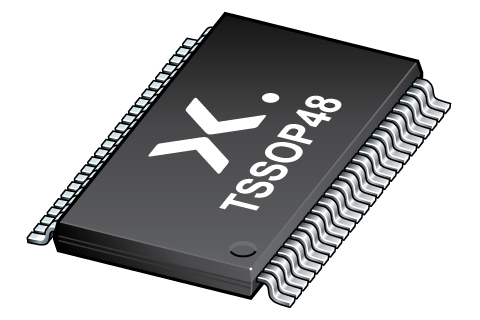
Register once, drag and drop ECAD models into your CAD tool and speed up your design.
Click here for more information74AVC16374DGG
16-bit edge triggered D-type flip-flop; 3.6 V tolerant; 3-state
The 74AVC16374 is a 16-bit edge triggered flip-flop featuring separate D-type inputs for each flip-flop and 3-state outputs for bus-oriented applications. The 74AVC16374 consist of 2 sections of 8 edge-triggered flip-flops. A clock input (CP) and an output enable (OE) are provided per 8-bit section.
The 74AVC16374 is designed to have an extremely fast propagation delay and a minimum amount of power consumption.
To ensure the high-impedance output state during power-up or power-down, nOE should be tied to VCC through a pull-up resistor (Live Insertion).
A Dynamic Controlled Output (DCO) circuitry is implemented to support termination line drive during transient.
Alternatives
Features and benefits
Wide supply voltage range from 1.2 V to 3.6 V
-
Complies with JEDEC standards:
JESD8-7 (1.2 V to 1.95 V)
JESD8-5 (1.8 V to 2.7 V)
JESD8-1A (2.7 V to 3.6 V)
CMOS low power consumption
Input/output tolerant up to 3.6 V
Dynamic Controlled Output (DCO) circuit dynamically changes output impedance, resulting in noise reduction without speed degradation
Low inductance multiple VCC and GND pins to minimize noise and ground bounce
Supports Live Insertion
Applications
Parametrics
| Type number | Package name |
|---|---|
| 74AVC16374DGG | TSSOP48 |
PCB Symbol, Footprint and 3D Model
| Model Name | Description |
|---|---|
|
|
Package
All type numbers in the table below are discontinued.
| Type number | Orderable part number, (Ordering code (12NC)) | Status | Marking | Package | Package information | Reflow-/Wave soldering | Packing |
|---|---|---|---|---|---|---|---|
| 74AVC16374DGG | 74AVC16374DGG,112 (935265484112) |
Obsolete | AVC16374 Standard Procedure Standard Procedure |

TSSOP48 (SOT362-1) |
SOT362-1 |
SSOP-TSSOP-VSO-WAVE
|
Not available |
| 74AVC16374DGG,118 (935265484118) |
Obsolete | AVC16374 Standard Procedure Standard Procedure | SOT362-1_118 | ||||
| 74AVC16374DGG,511 (935265484511) |
Obsolete | AVC16374 Standard Procedure Standard Procedure | Not available | ||||
| 74AVC16374DGG,512 (935265484512) |
Obsolete | AVC16374 Standard Procedure Standard Procedure | Not available | ||||
| 74AVC16374DGG,518 (935265484518) |
Obsolete | AVC16374 Standard Procedure Standard Procedure | Not available |
Environmental information
All type numbers in the table below are discontinued.
Series
Documentation (9)
| File name | Title | Type | Date |
|---|---|---|---|
| 74AVC16374 | 16-bit edge triggered D-type flip-flop; 3.6 V tolerant; 3-state | Data sheet | 2017-05-03 |
| AN90007 | Pin FMEA for AVC family | Application note | 2018-11-30 |
| AN90063 | Questions about package outline drawings | Application note | 2025-06-13 |
| SOT362-1 | 3D model for products with SOT362-1 package | Design support | 2020-01-22 |
| avc16374 | 74AVC16374 IBIS model | IBIS model | 2019-01-09 |
| Nexperia_package_poster | Nexperia package poster | Leaflet | 2020-05-15 |
| TSSOP48_SOT362-1_mk | plastic, thin shrink small outline package; 48 leads; 0.5 mm pitch; 12.8 mm x 6.1 mm x 1.2 mm body | Marcom graphics | 2017-01-28 |
| SOT362-1 | plastic thin shrink small outline package; 48 leads; body width 6.1 mm | Package information | 2024-01-05 |
| SSOP-TSSOP-VSO-WAVE | Footprint for wave soldering | Wave soldering | 2009-10-08 |
Support
If you are in need of design/technical support, let us know and fill in the answer form we'll get back to you shortly.
Longevity
The Nexperia Longevity Program is aimed to provide our customers information from time to time about the expected time that our products can be ordered. The NLP is reviewed and updated regularly by our Executive Management Team. View our longevity program here.
PCB Symbol, Footprint and 3D Model
| Model Name | Description |
|---|---|
|
|
How does it work?
The interactive datasheets are based on the Nexperia MOSFET precision electrothermal models. With our interactive datasheets you can simply specify your own conditions interactively. Start by changing the values of the conditions. You can do this by using the sliders in the condition fields. By dragging the sliders you will see how the MOSFET will perform at the new conditions set.